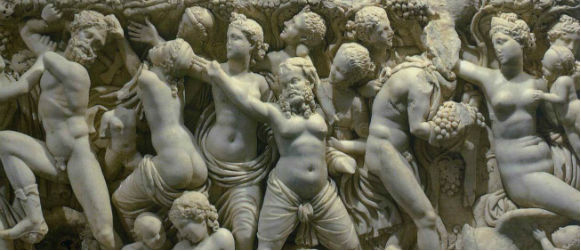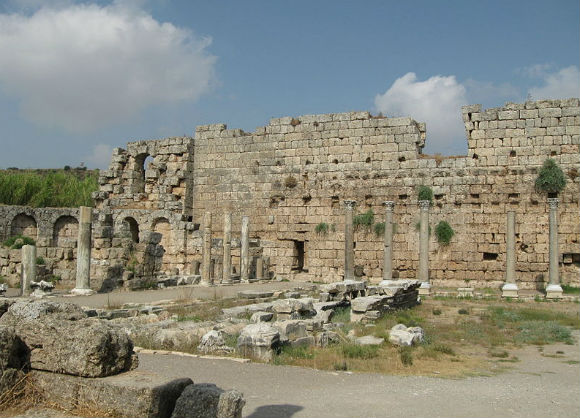Perga was an old city even in the first century. Its name (which is not Greek) indicates that its origin dates from pre-Greek times. Alexander the Great passed through it twice while the Pergaeans offered no resistance to him although it was a walled city with a citadel. In Roman times the main streets were over twenty-one meters wide. They were lined with Ionic colonnades and a water channel ran down their center in a series of small waterfalls as in Antalya today. Behind the colonnades stood the shops. Of the early buildings the stadium and the theater have survived the ravages of earthquakes and wars with the least damage. In fact this stadium which could seat about fourteen thousand people is one of the best preserved in Turkey.
The temple of the Pergaean Artemis according to a writer of the time was “a marvel of size, beauty, and workmanship.” Its location has yet to be established; it may have been where there are now ruins of a Byzantine church on a hill to the southeast of the city.
Perga is on a rise not far from the Cestrus River which was navigable In Paul’s time. It was not a seaport in terms of Its being directly on the Mediterranean even then, but rather it was more easily defended where it was: its distance from the open sea made it less vulnerable to piracy.
Two people stand out among the early residents of Perga. Apollonius was a third century B.C. astronomer and mathematician who believed that the movements of heavenly bodies in the universe were explainable by orbits within orbits: that the moon went around the earth as the earth went around the sun. He was much ahead of his time in his theories of astronomy, so much so that the ideas had to be rediscovered during the Renaissance. Plancia Magna was unusual for a second century A.D. woman: she held the highest city office during her life, that of demiurgus. She must have been well-to-do for a number of inscriptions record her gifts to the city.
Paul and Barnabas went through Perga on their way to and from Antioch on their first journey (Acts 13:13, 14:25). John Mark was with them at first but left them at Perga to return to Jerusalem. The reason for that must have been such that Paul doubted his commitment to the cause. Later when Paul and Barnabas were about to start on their second journey from Antioch they had a sharp dispute over his worthiness. Paul refused to have him go along, so John and Barnabas went to Cyprus while Paul chose Silas to accompany him.
Paul talks in II Corinthians 12:7 and in Galatians 4:13-14 of bodily illness that brought him to Galatia the first time. It may have been on that account that he did not stay long in Perga the first time. Whatever the illness was, it seems to have improved in time in the dry mountain air to the north.
The second theory of why they did not stay long in Perga is that their interview with Sergius Paulus, the proconsul of Cyprus, had made them want to hurry to the Roman colony in Antioch of Pisidia. This interpretation may lay too much stress on the lasting importance of that meeting with a cultured Roman who could have been more interested in the pursuits of the mind than the salvation, in Christian terms, of his soul. It is interesting, however, that this is” the point in Acts (13:9) that Luke begins to call Paul by his Roman name, not his Jewish “Saul”.
On their return they did stay in Perga long enough to preach and talk with people there. Nothing else is told about the city or their time there.
Perga,






Very interesting especially if you know Perge from reading about the Apostle Paul who travelled through here and Antalya. Some of the writings have been wonderfully preserved- especially the sign for the Butcher's shop! The Greek and Roman gates are beautiful as are the baths.
Perge was an eye opener. So much history there and much bigger than we expected. Even in the heat of the day we enjoyed the site. Wear flat shoes though!
I was very excited to visit Perge. A guide is essential to explain the Hellenistic and Roman remains. Some signage around the site with some background would have been helpful, and there is clearly a great deal of conservation work to be done.It tends not to be year round conservation as they depend on university staff and they are finance…
We went to a Roman ruin site where we discovered Greek ruins saw christian settlements and the great Roman baths. Yes it was a unique experience which stays with you for a long while.
At the onset all in mind was Friends, Romans and countrymen…. and when we left my 12 year old daughter was raving abou Heidies and Poseidon…
I enjoyed trying to imagine what it was like when people lived there. Had some interesting thoughts when I saw the public baths.
I was so impressed with this archaeologist site one of the best visited. Well laid out and signposted.you really get a feel for life in the past. Visited Hampi in India and whilst smaller compared town life across the continents.
we had a day trip out ,full of history amazing place ,if you like historic go here .take sun cream very hot and lots water.
What I enjoyed most about Perge was the variety of carved ruins. The site, including inside the stadium, was filled – seemingly littered – with pieces showing various decorative designs. The baths have been restored and through our guide it was interesting to learn and see how they were heated, and how the water was distributed and circulated.
This is a very large impressive site.The guided tour was very interesting. Well worth a visit. We went on a nice sunny day and even though it was March it was hot so do take a drink with you.
The place is huge. You can see the stadium, the theatre, the main square (acropola), the water system etc. You can climb on the hill above the site and you can see it from there… amazing view.
The walls around the city are also relatively preserved so you can see and feel the size of the city.
If you are…